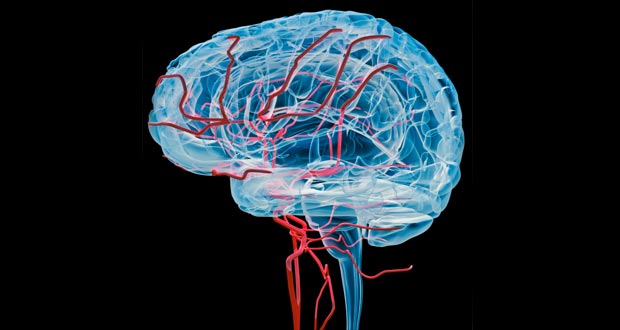Home Tags Posts tagged with "Imperial College London"
Imperial College London
According to a pilot study by Imperial College London, infusing stem cells into the brain may help boost recovery after a stroke.
Scientists believe the cells encourage new blood vessels to grow in damaged areas of the brain.
They found most patients were able to walk and look after themselves independently by the end of the trial, despite having suffered severe strokes.
Larger studies are needed to evaluate whether this could be used more widely.
In this early trial – designed primarily to look at the safety of this approach – researchers harvested stem cells from the bone marrow of five people who had recently had a stroke.

Infusing stem cells into the brain may help boost recovery after a stroke
They isolated particular types of stem cells – known as CD34+. These have the ability to stimulate the growth of new blood vessels.
They were infused directly into damaged sections of the brain, via the major artery that supplies this area.
Scientists monitored the patients for six months, charting their ability to carry out everyday activities independently.
Four of the five patients had suffered particularly severe strokes – resulting in the loss of speech and marked paralysis down one side of the body.
This type of stroke usually has a high fatality and disability rate.
However, researchers found three of the four patients were able to walk and look after themselves independently at the end of the six-month period.
With some help, all five were mobile and could take part in everyday tasks.
Though other stem cell treatment has shown promise as stroke therapy before.
Scientists hope getting to patients early will improve chances of success.
The study is published in Stem Cell Translational Medicine.
Massachusetts Institute of Technology tops the world’s top 20 universities, according to the new QS World University rankings.
Harvard University comes second and UK’s University of Cambridge is in third position.
University College London (UCL) and Imperial occupied fourth and fifth places, with Oxford in sixth.
Universities in the United States made up the rest of the top 10.
Top 20 universities:
1. Massachusetts Institute of Technology (MIT)
2. Harvard University
3. University of Cambridge
4. University College London (UCL)
5. Imperial College London

Massachusetts Institute of Technology tops QS World University Rankings in 2013
6. University of Oxford
7. Stanford University
8. Yale University
9. University of Chicago
10=. California Institute of Technology (Caltech)
10=. Princeton University
12. Eth Zurich (Swiss Federal Institute of Technology)
13. University of Pennsylvania
14. Columbia University
15. Cornell University
16. Johns Hopkins University
17=. University of Edinburgh
17=. University of Toronto
19=. Ecole Polytechnique Fédérale de Lausanne
19=. King’s College London
[youtube KW3B-WKAmkc]
An “intelligent” microchip which can suppress appetite has been designed by a group of British scientists.
Animal trials of the electronic implant are about to begin and its makers say it could provide a more effective alternative to weight-loss surgery.
The chip is attached to the vagus nerve which plays a role in appetite as well as a host of other functions within the body.
Human trials of the implant could begin within three years, say its makers.
The work is being led by Prof. Chris Toumazou and Prof. Sir Stephen Bloom of Imperial College London.

Animal trials of the electronic implant are about to begin and its makers say it could provide a more effective alternative to weight-loss surgery
It involves an “intelligent implantable modulator”, just a few millimetres across, which is attached using cuff electrodes to the vagus nerve within the peritoneal cavity found in the abdomen.
The chip and cuffs are designed to read and process electrical and chemical signatures of appetite within the nerve. The chip can then act upon these readings and send electrical signals to the brain reducing or stopping the urge to eat.
The researchers say identifying chemicals rather than electrical impulses will make for a more selective, precise instrument.
The project has just received over 7 million euros ($9 million) in funding from the European Research Council.
A similar device designed by the Imperial team has already been developed to reduce epileptic seizures by targeting the same vagus nerve.
“This is a really small microchip and on this chip we’ve got the intelligence which can actually model the neural signals responsible for appetite control,” Prof. Chris Toumazou said.
“And as a result of monitoring these signals we can stimulate the brain to counter whatever we monitor.
“It will be control of appetite rather than saying don’t eat completely. So maybe instead of eating fast you’ll eat a lot slower.”
Prof. Chris Toumazou said initial laboratory trials had already demonstrated proof of concept.
Prof. Stephen Bloom, who heads Imperial’s diabetes, endocrinology and metabolism division, said the chip could provide an alternative to “gross surgery”.
British researchers have developed a cheap test which could detect even low levels of viruses and some cancers.
The colour of a liquid changes to give either a positive or negative result.
Researchers from Imperial College London say the device could lead to more widespread testing for HIV and other diseases in parts of the world where other methods are unaffordable.
The prototype, which needs wider testing, is described in the journal Nature Nanotechnology.
The test can be configured to a unique signature of a disease or virus – such as a protein found on the surface of the HIV.

Cheap colour test could detect HIV, other viruses and some cancers, blue for yes, red for no
If that marker is present it changes the course of a chemical reaction. The final result is blue if the marker is there, red if the marker is not.
The researchers say this allows the results to be detected with “the naked eye”.
Prof. Molly Stevens said: “This method should be used when the presence of a target molecule at ultra-low concentration could improve the diagnosis of disease.
“For example, it is important to detect some molecules at ultra-low concentrations to test cancer recurrence after tumor removal.
“It can also help with diagnosing HIV-infected patients whose viral load is too low to be detected with current methods.”
Early testing showed the presence of markers of HIV and prostate cancer could be detected. However, trials on a much larger scale will be needed before it could be used clinically.
The researchers expect their design will cost 10 times less than current tests. They say this will be important in countries where the only optifons are unaffordable.
Fellow researcher Dr. Roberto de la Rica said: “This test could be significantly cheaper to administer, which could pave the way for more widespread use of HIV testing in poorer parts of the world.”
Researchers have found that brain scans show that skipping breakfast makes fatty, high calorie foods appear far more attractive later in the day.
Scans of 21 people showed the brain was more attracted to food if breakfast was missed and people had more food at lunch.
Scientists said it made loosing weight challenging as missing meals made calorific food even more appealing.
Nutrition experts say breakfast is known to take the edge off appetite.
However, researchers were curious about what happened inside the brain to alter the food people choose to eat.
Twenty one people, who were all normal weight, were shown pictures of calorie packed foods while they were positioned in a magnetic resonance imaging (MRI) machine at Imperial College London.
On one day they were given no breakfast before the scans and on a different day they were fed a large, 730 calorie, breakfast an hour and a half before.
The researchers said skipping breakfast created a “bias” in the brain in favor of high calorie foods.
The results, presented at the Neuroscience 2012 conference, showed the brain changed how it responded to pictures of high calorie foods, but not low calorie foods, when breakfast was skipped.
They showed part of the brain thought to be involved in “food appeal”, the orbitofrontal cortex, became more active on an empty stomach.
When the researchers offered the participants lunch at the end of the study, people ate a fifth more calories if breakfast was missed.
Dr. Tony Goldstone, from Imperial College London, said: “Through both the participants’ MRI results and observations of how much they ate at lunch, we found ample evidence that fasting made people hungrier, and increased the appeal of high calorie foods and the amount people ate.
“One reason it is so difficult to loose weight is because the appeal of high calorie food goes up.”
Future studies will investigate how obesity affects the same system in the brain.
A jab that allows damaged hearts to heal themselves and could be given by paramedics in the back of ambulances is being developed at a British university.
Scientists at Imperial College London hope that giving heart attack victims an injection of stem cells will trick the organ into repairing itself, saving lives and greatly cutting the odds of further ill health.
Crucially, and unlike other techniques being tested on patients in the UK, the cells they plan to use are from a person’s own heart, an innovation they believe increases the odds of the treatment being a success.
They are close to applying for permission to test the jab on patients.
If trials on heart attack survivors are successful, the injection could eventually be given by paramedics just minutes after a heart attack and before patients even reach hospital.

A jab that allows damaged hearts to heal themselves and could be given by paramedics in the back of ambulances is being developed at Imperial College London
The jab is one of several treatments being researched by the British Heart Foundation as part of its multi-million-pound Mending Broken Hearts project to improve the care of heart attack patients.
The aim is to cut the odds of heart failure, in which the heart, weakened by one, or a series of heart attacks, struggles to pump blood around the body.
In the most severe cases, the lungs ‘drown’ in fluid.
Treatments range from drugs to transplants but with 40% of those affected dying within a year of diagnosis, heart failure has a worse survival rate than many cancers.
Doctors and scientists around the world are trying to use stem cells – “blank” cells able to turn into various types of tissue – to shore up ailing hearts.
But most have focused on cells taken from bone marrow and improvements have been slight.
The Imperial team believes that stem cells from the heart will be much more successful.
These cells are extremely rare, with just 300 per million normal heart cells, meaning the lack the power needed to repair the damage wrought by a heart attack.
But the scientists have found a way of extracting them from a patient’s own heart, and growing them in huge numbers the laboratory, before injecting them back into the hear
Once there, they patch up the ailing tissue, with tests on mice showing stem cells taken from the animals’ hearts trigger the growth of new tissue and blood vessels.
The human version of the jab has also been tested on pigs and the researchers are one to two years away from applying for permission to test the treatment on patients.
With it taking three to four months to grow enough cells for each jab, the first patients will be treated several months after a heart attack.
But in time, it may be possible to create a one-size-fits-all jab, allowing almost immediate treatment, said researcher Professor Michael Schneider.
Esther Rantzen, who is backing the Mending Broken Hearts appeal and whose late husband, the documentary maker, Desmond Wilcox battled heart disease for years, said: “If hearts learn to heal themselves, then people who are bed-bound, who are imprisoned in their own homes, who can’t walk upstairs, who can’t involve themselves in any physical activity could be restored to health and their family life greatly improved.”
Prof. Michael Schneider is also trying to find ways of stopping cells from dying during a heart attack.
Other work being funded by the BHF includes research into a pill that could be given in advance to those at high risk of heart attacks and patches of cells that could patch up the heart.
Professor Peter Weissberg, the charity’s medical director, said that despite advances in cardiac medicine, a good treatment for severe heart failure has remained elusive.
“Although we have been able to prevent heart attacks and treat people with heart attacks when they occur, we haven’t been able to stop the damage that occurs when a heart attack takes place.
“The reason we are making such a noise about it now is that science has progressed to a point where it looks biologically feasible that we might be able to create new heart cells to repair the heart.
“Ten years ago, that would have been science function.”
Eating plenty of cereals and whole grains could reduce the risk of developing colorectal cancer, a study published in British Medical Journal says.
Scientists from Imperial College London found that for every 10 g a day increase in fibre intake, there was a 10% drop in the risk of bowel cancer.
Researchers’ analysis of 25 previous studies found that fruit and vegetable fibre did not reduce risk.
A cancer charity called for more detailed research on the quantity and type of fibre to eat.
Eating fibre and whole grains is known to help protect against cardiovascular disease, but experts say that any link with colorectal cancer is less clear because studies have not had consistent results.
Reviewing the results of all previous observational studies in this area, researchers in London, Leeds and the Netherlands analysed data provided by almost 2 million people.

Eating plenty of cereals and whole grains could reduce the risk of developing colorectal cancer, a study published in British Medical Journal says
Researchers’ conclusion, published in the BMJ, is that increasing fibre intake, particularly cereal fibre and whole grains, helps prevent colorectal cancer.
Whole grains include foods such as whole grain breads, brown rice, cereals, oatmeal and porridge.
Dagfinn Aune, lead study author and research associate in the department of epidemiology and biostatistics at Imperial College London, said their analysis found a linear association between dietary fibre and colorectal cancer.
“The more of this fibre you eat the better it is. Even moderate amounts have some effect.”
Adding 3 servings (90 g per day) of whole grains to diets was linked to a 20% reduction in the risk of colorectal cancer, researchers said.
Cancer Research UK data shows that the lifetime risk of being diagnosed with colorectal cancer in the UK is estimated to be one in 14 (6.9%) for men, and one in 19 for women (5.4%).
However, the study said there was no evidence that fibre in fruit and vegetables played a part in reducing risk.
A previous study which showed a reduction in risk with high intake of fruit and vegetables suggests that compounds other than fibre in fruit and vegetables could account for this result, said the authors.
The researchers also said that the health benefits of increasing fibre and whole grains intake was not restricted to colorectal cancer.
“It is also likely to reduce the risk of cardiovascular disease, type 2 diabetes, overweight and obesity, and possibly overall mortality,” they said.
Mark Flannagan, chief executive of Beating Bowel Cancer, said the research supported the charity’s current advice.
“These results support what we already know about the link between dietary fibre and a reduced risk of bowel cancer, although more work is needed to clarify the quantity and types of fibre we should be eating to reduce risk.
“We recommend that people eat a healthy balanced diet that includes plenty of dietary fibre, such as grains, cereals, fruit and vegetables to reduce the risk of developing bowel cancer.
“It is encouraging to know that simple changes to your diet and lifestyle could help protect you from the UK’s second biggest cancer killer.”
Yinka Ebo, senior health information officer at Cancer Research UK, said the review added weight to the evidence that fibre protects against bowel cancer.
“It shows that certain sources of fibre, such as cereal and whole grains, are particularly important.
“Eating plenty of fibre is just one of many things you can do to lower your risk of developing the disease, along with keeping a healthy weight, being physically active, cutting down on alcohol, red and processed meat, and not smoking.”
In an accompanying editorial in the BMJ, Professor Anne Tjonneland from the Danish Cancer Society, said whole grain products should be made more appealing to shoppers.
“To increase the intake of these foods in Western countries, the health benefits must be actively communicated and the accessibility of whole grain products greatly improved, preferably with a simple labelling system that helps consumers to choose products with high whole grain contents.”
Cancer of the large bowel, also known as colorectal cancer, is a common form of cancer in developed countries – but occurs much less frequently in the developing world.
WHAT ARE WHOLE GRAINS?
* Whole grain breads
* Whole grain rye breads
* Whole grain cereals
* High fibre cereals
* Brown rice
* Oatmeal
* Porridge






